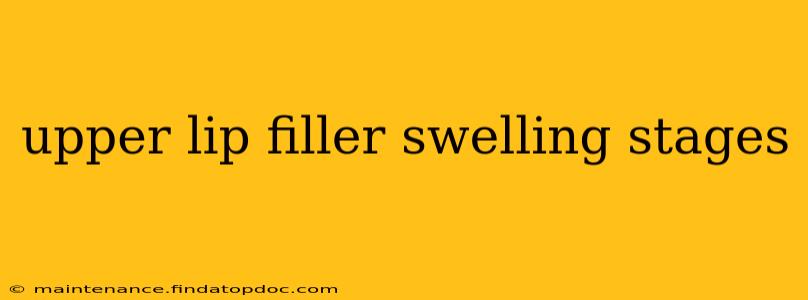Getting lip fillers is a popular cosmetic procedure, offering a way to enhance lip volume and shape. However, understanding the swelling stages after upper lip filler injection is crucial for managing expectations and ensuring a smooth recovery. This guide will walk you through the typical swelling progression, answer frequently asked questions, and provide tips for minimizing discomfort and maximizing results.
What are the Typical Swelling Stages After Upper Lip Filler?
The swelling process after upper lip filler injection is usually predictable, although individual experiences may vary. Here's a general timeline:
Immediately After Injection: You'll likely experience some immediate swelling, which can range from mild to moderate. This is a normal response to the injection and the introduction of filler into the tissue. The area may feel slightly tender or firm.
Day 1-3: Swelling typically peaks within the first 24-72 hours. This is the stage where you'll likely notice the most significant swelling. The lips may appear noticeably larger and potentially slightly misshapen. This is temporary and part of the healing process.
Day 4-7: Swelling begins to gradually subside. You should see a noticeable reduction in swelling during this period. The lips will still appear fuller than before the procedure, but the puffiness should be diminishing.
Week 2 onwards: Most swelling should be gone by two weeks post-procedure. However, some residual swelling or firmness may linger for several more weeks as your body continues to integrate the filler. The final results will become fully apparent after this period.
How Long Does Upper Lip Filler Swelling Last?
The duration of swelling varies depending on several factors, including:
- Amount of filler injected: Larger volumes of filler generally lead to more pronounced and longer-lasting swelling.
- Type of filler used: Different filler types have different properties and may cause varying degrees of swelling. Your injector will discuss the specific filler used.
- Individual response: Individual healing processes vary, leading to differences in swelling duration and intensity.
- Aftercare followed: Adhering to aftercare instructions helps minimize swelling and inflammation.
While most swelling resolves within 2 weeks, some residual swelling can persist for several more weeks. It's important to be patient and allow your body sufficient time to heal.
What Can I Do to Reduce Swelling After Upper Lip Filler?
Several strategies can help minimize swelling and discomfort:
- Ice packs: Apply ice packs wrapped in a clean cloth to the treated area for 15-20 minutes at a time, several times a day, during the first 24-48 hours.
- Elevation: Keep your head elevated when sleeping to reduce fluid buildup.
- Avoid strenuous activity: Refrain from strenuous exercise or activities that increase blood flow to the face for the first few days.
- Limit alcohol and caffeine: These substances can increase inflammation.
- Follow your injector’s aftercare instructions: These instructions will provide specific recommendations based on the filler used and your individual situation.
Is it Normal to Have Bruising After Upper Lip Filler?
Yes, bruising is also a common side effect of lip filler injections. It typically appears as small, red or purple spots or larger areas of discoloration. Bruising generally resolves within 7-10 days. Cold compresses can also help minimize bruising.
When Should I Worry About Swelling After Lip Fillers?
While some swelling is normal, it’s crucial to contact your injector if you experience:
- Severe or persistent swelling: Swelling that doesn't improve or worsens significantly after several days.
- Excessive pain or discomfort: Pain that is unmanageable despite over-the-counter pain relief.
- Signs of infection: Redness, warmth, pus, or increased pain at the injection site.
- Asymmetry: Significant asymmetry in lip appearance that persists after the initial swelling subsides.
Remember, the information provided here is for general knowledge and shouldn't replace professional medical advice. Always consult with your qualified injector regarding any concerns or questions you may have. They can provide personalized guidance based on your individual circumstances.
